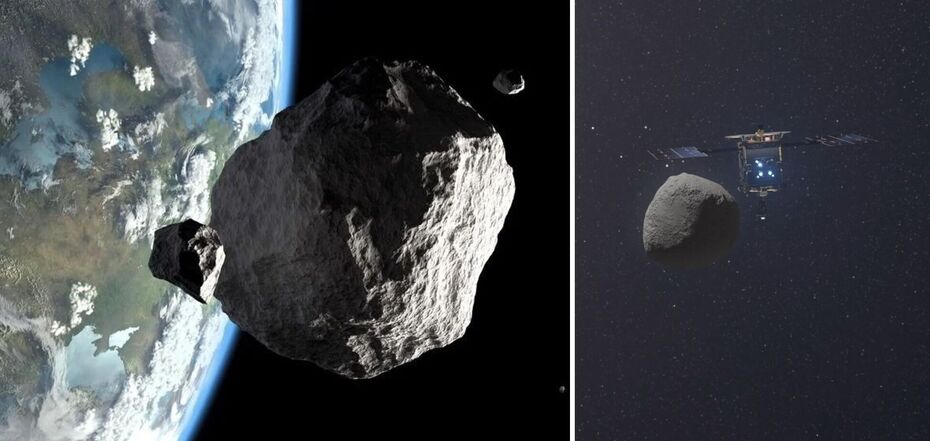Life
On the asteroid Ryugu, flying past Earth and Mars, discovered organics that could create life
A sample obtained by NASA from Ryugu, a near-Earth asteroid more than 900 meters wide, found organic compounds that support the theory that life on Earth could have originated thanks to a "space visitor. The samples were collected by Japan's Hayabusa2 spacecraft on Feb. 22, 2019, and returned to Earth in December 2020.
Scientists received only a tiny particle, 30 milligrams of rock from the asteroid, for study. The samples were collected and delivered for study under controlled conditions, reducing the chance of accidental contamination or atmospheric contamination on Earth.
The results of the study of the first samples were published in the scientific publication Science, Phys. Scientists noted that the organic compounds found were probably the result of an aqueous reaction on Ryugu's mother body.
Organic molecules are the building blocks of all known life forms on Earth and consist of a wide range of compounds containing carbon in combination with hydrogen, oxygen, nitrogen, sulfur and other atoms.
According to the researchers, the "prebiotic" organic matter found in the Ryugu sample contained several types of amino acids, compounds used as the building blocks of proteins in life on Earth.
The sample also contained various organic compounds formed in the presence of liquid water, including aliphatic amines, carboxylic acids, aromatic polycyclic hydrocarbons and nitrogen-containing heterocyclic compounds.
Professor Hiroshi Naraoka, a planetary scientist at Kyushu University in Japan, who studied the samples, believes that the molecules could have traveled through space on the asteroid and at some point dispersed like interplanetary dust. They could have been ejected due to collisions with other space objects or for some other reason. Subsequently, they could fall on one of the planets of the solar system.
The professor also noted that the scientists were lucky that the molecules, as the asteroid during its space journey is constantly exposed to solar heating, ultraviolet radiation and cosmic ray irradiation in a high vacuum.
According to one theory, life on planet Earth could not originate on its own, so its emergence was preceded by the fall of an asteroid containing the so-called building blocks of life. You can read more about this theory here.
Another researcher, astrobiologist Dr. Jason Dworkin of NASA's Goddard Space Flight Center, noted that the findings in the Ryugu sample are consistent with what has previously been observed in carbon-rich meteorites.
However, his colleague astrobiologist Dr. Daniel Glavin notes that scientists have not yet been able to detect sugar and nucleic bases, components of DNA and RNA, in the Ryugu sample. He suggests that these compounds are also present in the asteroid Ryugu, but scientists simply have not been able to calculate them because of the "relatively small mass of the sample available for study.
In the future, scientists intend to compare samples from Ryugu with those from the asteroid Bennu when NASA's OSIRIS-REx mission returns it to Earth in 2023.
The sample from the Hayabusa2 spacecraft was taken in Japan in July 2021 and analyzed at Goddard in fall 2021. The 30-milligram sample was extracted (like tea) with many different solvents in Japan and analyzed at laboratories in Japan, Goddard and Europe using a wide range of equipment similar to that used in forensic laboratories.
The asteroid Ryugu orbits between Earth and Mars. Scientists believe that it contains intact organic material from the origin of the solar system and may hold clues to the formation and evolution of life.
Ryugu was discovered on May 10, 1999, at Lincoln Laboratory in the United States. It was originally named 1999 JU3 and only later was the discovery officially named Ryugu.
Such a strange name is of Japanese origin and refers to Ryugu-jo (Dragon Palace). In the Japanese folk tale is a magical underwater palace, to which the fisherman Urashima Taro travels on the back of a turtle. From the palace, Taro returns with a mysterious box, just as Hayabusa2 returned to Earth with specimens.
For scientists, asteroids like Ryugu are unique archives from the early days of the solar system, material stored in a deep freeze, and therefore unchanged, from a time before planets were formed.
When scientists first examined samples from Ryugu, they noticed that the space rock from the asteroid was darker and more porous than expected. This fragility is important in terms of assessing whether it or similar asteroids might one day threaten Earth.
Earlier OBOZREVATEL also reported that scientists have found minerals unknown to mankind in a 17-ton meteorite.
Subscribe to OBOZREVATEL channels in Telegram and Viber to keep up with the latest news.




























